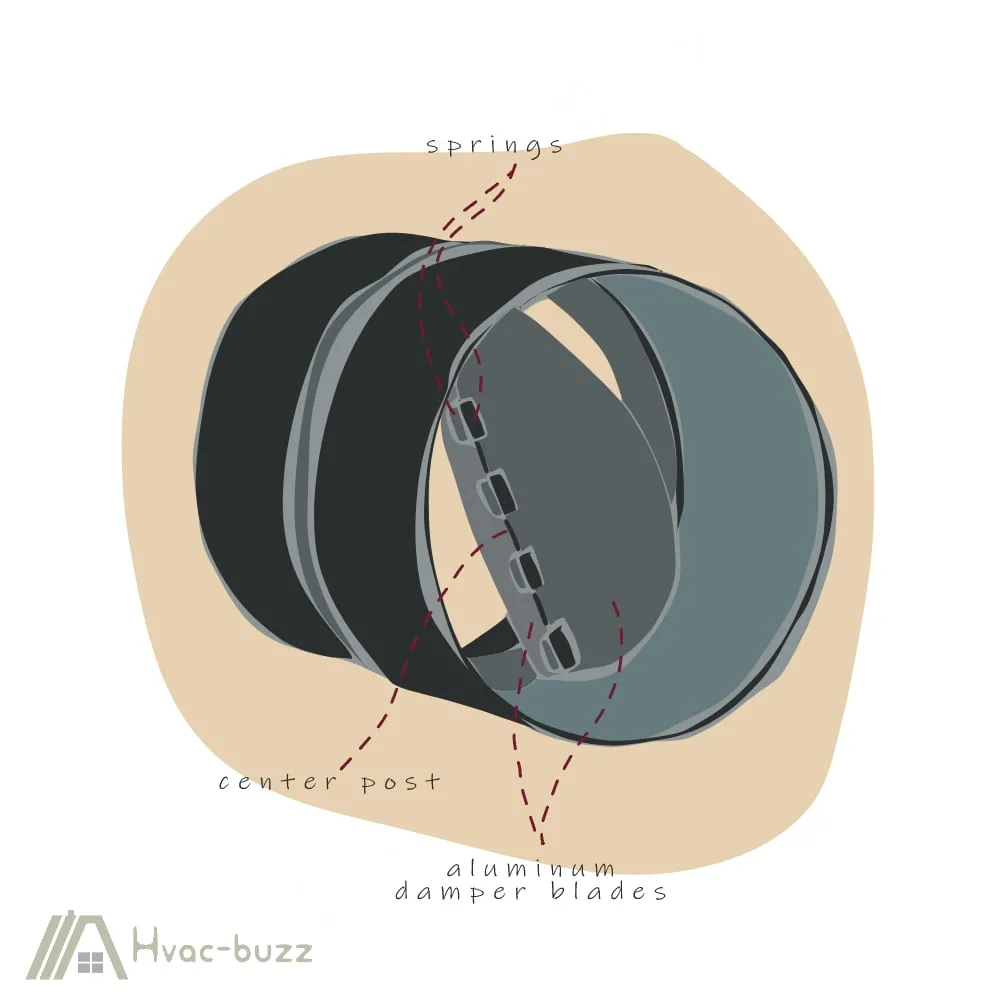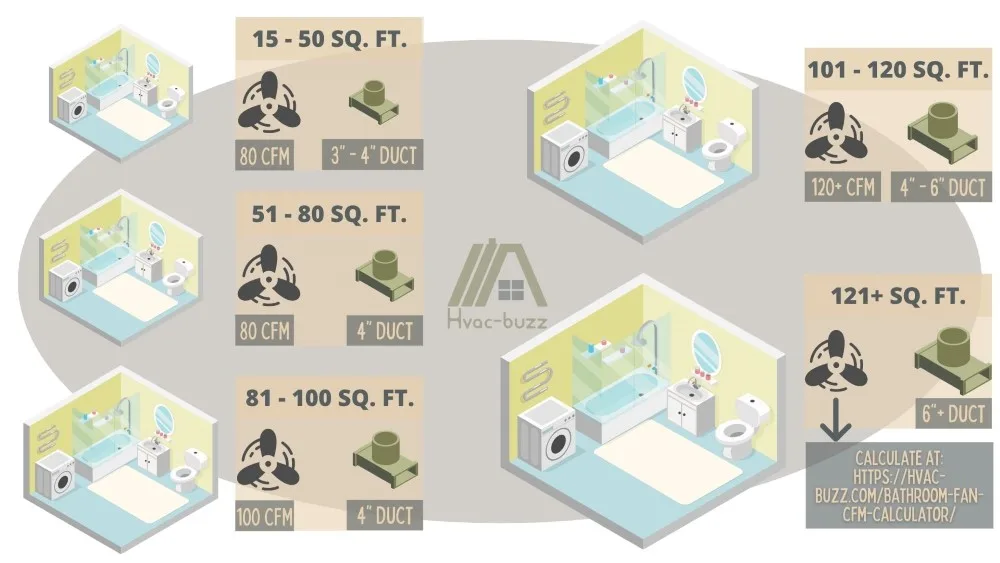Bathroom fans are necessary, but they do not need to cost you an arm and a leg or interrupt your nice, hot bubble bath. You should not be struggling to keep your bathroom and house warm (or cool) because of your bathroom fan.
A bathroom fan is designed to extract heat, yes, but it should not be doing so beyond what is necessary to remove stale and humid air from your bathroom. Thankfully, there are a few tips that can help you prevent heat loss and hopefully quickly get you back to a reasonable heating bill and comfort level in your bathroom.

Heat extracted by a bathroom fan can become excessive during use or when the fan is off. This heat loss can be minimized by using separate switches for the light and fan, a quality backdraft damper, the correct size fan, a timer switch or humidity sensor, insulation, or a heat exchanger.
Heat Loss During Operation
The purpose of your bathroom exhaust fan is to remove hot and moist air from the bathroom before it can cause damage. Thus, part of its function is the ability to remove heat.
This makes having a nice long soak in a hot bath quite difficult (unless you have a heated whirlpool bathtub), and it can also result in air warmed by your HVAC system being exhausted outside. Now, this is a necessary evil while you are showering or bathing because having no ventilation in a bathroom is extremely problematic.
However, if your bathroom fan is linked to the only light in the bathroom, then every time you flip the light switch, your fan will turn on and start pulling warm air out of the house. This occurs when you go to the toilet, brush your teeth, check your face in the mirror, etc. None of these activities require the fan to be on, so this loss of heat is pointless and frustrating.
Some people use this principle to their advantage as a “hack” way to cool the house down in the summertime. Of course, it has limited effectiveness when the outside temperatures are greater than the interior temperatures.
Loss of Heat When Fan Is Off
Thinking about it in the simplest of terms, the bathroom fan is a hole in your house. The vents are seldom louvered, so you cannot shut the fan vent when it is not in use, and the backdraft damper at the other end (leading outside), is designed to allow air to pass through it to the outside.
However, the force of the air passively moving through the ducts should not be sufficient to open the flaps of the damper if it is operating properly.
So, it seems almost natural that heat would be passively lost through the fan into the ductwork and to the outside. However, certain factors will make heat loss through your exhaust fan worse.
Leaky Backdraft Damper
If your backdraft damper is not quite airtight, then it is possible for air currents to flow from the bathroom to the outside, taking the warm air away from the living spaces. This is not a normal occurrence, so don’t just accept it. Backdraft dampers should be sealed properly.

Uninsulated Ductwork
When your ducts are uninsulated, and particularly if your ducts run through unconditioned parts of the house such as an unencapsulated crawl space or a poorly insulated attic, then the air in the ducts is colder than air in the bathroom and house in general.
Physics is simple when it comes to temperature gradients. Heat will always be transferred to surfaces, substances, or mediums that are colder than those containing heat.
In this case, hot air will always transfer its heat to colder air. So, while the hot air itself might not actually be moving out of the bathroom and into the ductwork where it serves no purpose, the heat that it contains will be transferred to the cooler air in the ducts.
6 Tips to Minimize Heat Loss Through Bathroom Fan
Thankfully, there are some tips and tricks to help you out with heat loss. They are mostly straightforward and relatively easy to employ.
1. Have Separate Switches for Fan and Light
A great solution to stop the fan from functioning unnecessarily is to have separate switches for the bathroom fan and light. You can just install a two-button switch point and connect the wires separately to each button (or have an electrician do it!).
Now, this brings in the matter of needing to know how long to run the fan after you shower. Because your bathroom has a fan for a reason, and it needs to serve its purpose.
If you turn the fan off directly after you finish showering, then the fan will not have sufficient time to ventilate the bathroom from residual moisture and heat and all the issues of poor ventilation will set in along with a higher electricity bill. 20 minutes should be sufficient time for the fan to clear the air before you switch it off.
2. Purchase a Quality Backdraft Damper
A quality backdraft damper, such as the one pictured below, can be an asset to your heat loss problem. In many cases, it is the ultimate solution. This type of damper allows air to travel through a ventilation system in one direction without allowing backflow.
- An antidraft duct insert designed for use with range hoods, bathroom fans and other home HVAC applications.
- Features outer rubber gaskets that create an airtight seal and grip between the damper and ducts.
- Mounts horizontally or vertically to prevent backflow and debris from entering ducting.
- Galvanized steel body with spring-loaded aluminum damper blades that open with minimal airflow.
Last update on 2024-03-28 / Affiliate links / Images from Amazon Product Advertising API
With a good damper, you will also receive an airtight seal. An airtight seal will prevent hot air from leaking out of the ventilation system when the bathroom fan is not on. But this needs to close properly.
A spring butterfly backdraft damper is the best option for a bathroom as it is physically closed by the spring mechanism, creating a good air seal. Gravity backdraft dampers might not seal as well, which will allow heat to escape.
The best quality damper to use in your bathroom is one that suits your needs (meets the requirements for and is intended for use in a bathroom) and is listed. Being listed means that the quality and function are approved by the International Residential Code (IRC) and meet the requirements and specifications required by the IRC.
This damper should be installed at the exit point of your exhaust duct either on the roof or external wall of your house, or where the duct meets the general ventilation shaft of the building for apartment living.
3. Size Your Fan Correctly
If the fan in your bathroom is too big or powerful, the exhaust rate provided by the fan will exceed the rate needed for the bathroom. Too high exhaust rates will suck too much air from the room and can lead to unwanted heat loss.
You can find out the required exhaust rates for your bathroom size using this bathroom fan CFM calculator, which is derived from the IRC specifications.

With the correct size fan, you won’t have excessive ventilation in the bathroom that will cost you comfort and high utility bills.
4. Install a Timer Switch or Humidity Sensor
Installing a timer switch or humidity sensor for your bathroom fan will control when the fan operates and can prevent heat loss from occurring as a result of the fan being on for unnecessary amounts of time.
These timer switches are highly customizable and have several different timers that help to automatically control when and how long your fan is on for. This also means you don’t have to worry about remembering to turn the fan off. You can look at some of the best bathroom fan timer switches and decide which one suits your needs best.
A bathroom fan with a humidity sensor provides precise functionality. The fan will switch on automatically when the humidity levels in the bathroom reach a pre-set level and will turn off automatically when the sensor registers that the moisture in the bathroom has dropped to an acceptable percentage.
Not only do humidity sensors save you from excessive heat loss, but they offer many other benefits over manual fans that can answer your question of whether a humidity sensing bathroom fan is worth it.
5. Insulate Ductwork and Unconditioned Spaces
It is important to insulate the ducting for the bathroom fan. This helps to prevent heat loss from the bathroom by mitigating the difference in temperature between bathroom air and air in the ducts. This is particularly relevant in areas that experience colder falls and winters.
You can also insulate around your fan. You can find instructions for how and where to insulate around your bathroom fan here.
Insulation will also prevent dripping from the fan as a result of condensation formation in the ducts.
The bathroom needs to be sufficiently insulated from unconditioned spaces such as crawl spaces, attics, or roof spaces. If they are not properly separated, your conditioned air will be drawn into the colder areas, resulting in heat loss.
6. Investigate a Fan With a Heat Exchanger
A heat exchanger is part of a heat recovery system that can be installed in your residence for a specific area or as part of your HVAC system.
When the bathroom fan removes heated and humid air from the bathroom, this heat is incorporated into your HVAC system and can be used to heat incoming air.
The system offers a low rate of continuous ventilation that gets boosted to a higher rate when the bathroom is in use. This increases the efficiency of your bathroom ventilation and prevents excessive air from being exhausted from the bathroom all the time.
This is a great way to minimize the heat loss through your bathroom fan as the heat is not being lost at all, and you will be able to save on utility bills and noisy fans around the house.
Heat Can Also Enter Through Bathroom Fan
AS you can see, without the correct size and accessories, bathroom fans can interfere with your HVAC system.
It is crucial for bathroom fans to have backdraft dampers and they must be appropriately installed to function correctly.
The damper will keep both cold external air as well as hot external air out of your bathroom. This is helpful in summer when you are trying to cool the house down and can save you from large AC bills.
Without a functioning damper in the bathroom, your conditioned air will leak through the bathroom exhaust fan, and, in return, it will allow hot air to filter in. Without the damper, your thermal barrier is not intact, meaning you cannot isolate the internal, conditioned air from the external, unconditioned air.
The size of your fan is also relevant here. If it is too powerful, it will unbalance the air pressure system, which can negatively impact your damper and pull hot air through where it shouldn’t.
Insulation is another factor that works for both cold and hot air. Insulation keeps warm air in the bathroom, but it also stops the unwanted transfer of hot air into the bathroom.
The short of it is this: these tips are intended to help increase the efficiency of your HVAC system. Not only will they help prevent heat loss from your bathroom fan, but they will also help to keep your utility bill down by keeping hot air out.
Sources
http://www.iaqsource.com/article.php/bath-ventilation-with-hrv-smart-move/?id=88
https://laokoonlamp.com/how-to-wire-a-bathroom-fan-and-light-on-separate-switches/
https://www.energy.gov/energysaver/whole-house-ventilation
https://www.lakesideac.com/blog/are-exhaust-fans-causing-heat-loss-in-your-home





